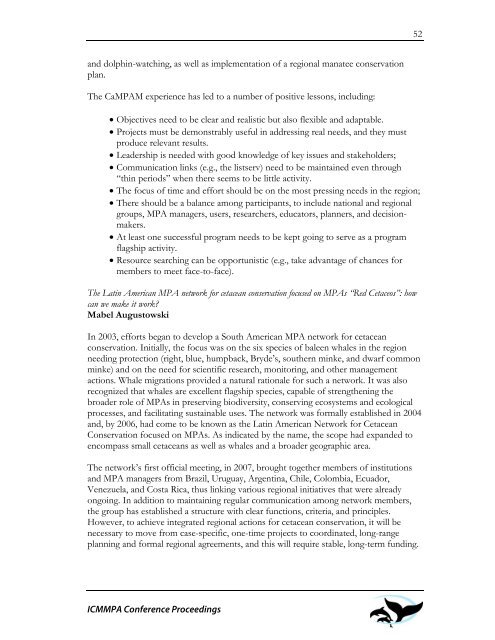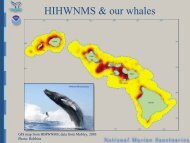The First International Conference on Marine Mammal Protected Areas
The First International Conference on Marine Mammal Protected Areas
The First International Conference on Marine Mammal Protected Areas
You also want an ePaper? Increase the reach of your titles
YUMPU automatically turns print PDFs into web optimized ePapers that Google loves.
and dolphin-watching, as well as implementati<strong>on</strong> of a regi<strong>on</strong>al manatee c<strong>on</strong>servati<strong>on</strong><br />
plan.<br />
<str<strong>on</strong>g>The</str<strong>on</strong>g> CaMPAM experience has led to a number of positive less<strong>on</strong>s, including:<br />
• Objectives need to be clear and realistic but also flexible and adaptable.<br />
• Projects must be dem<strong>on</strong>strably useful in addressing real needs, and they must<br />
produce relevant results.<br />
• Leadership is needed with good knowledge of key issues and stakeholders;<br />
• Communicati<strong>on</strong> links (e.g., the listserv) need to be maintained even through<br />
“thin periods” when there seems to be little activity.<br />
• <str<strong>on</strong>g>The</str<strong>on</strong>g> focus of time and effort should be <strong>on</strong> the most pressing needs in the regi<strong>on</strong>;<br />
• <str<strong>on</strong>g>The</str<strong>on</strong>g>re should be a balance am<strong>on</strong>g participants, to include nati<strong>on</strong>al and regi<strong>on</strong>al<br />
groups, MPA managers, users, researchers, educators, planners, and decisi<strong>on</strong>makers.<br />
• At least <strong>on</strong>e successful program needs to be kept going to serve as a program<br />
flagship activity.<br />
• Resource searching can be opportunistic (e.g., take advantage of chances for<br />
members to meet face-to-face).<br />
<str<strong>on</strong>g>The</str<strong>on</strong>g> Latin American MPA network for cetacean c<strong>on</strong>servati<strong>on</strong> focused <strong>on</strong> MPAs “Red Cetaceos”: how<br />
can we make it work?<br />
Mabel Augustowski<br />
In 2003, efforts began to develop a South American MPA network for cetacean<br />
c<strong>on</strong>servati<strong>on</strong>. Initially, the focus was <strong>on</strong> the six species of baleen whales in the regi<strong>on</strong><br />
needing protecti<strong>on</strong> (right, blue, humpback, Bryde’s, southern minke, and dwarf comm<strong>on</strong><br />
minke) and <strong>on</strong> the need for scientific research, m<strong>on</strong>itoring, and other management<br />
acti<strong>on</strong>s. Whale migrati<strong>on</strong>s provided a natural rati<strong>on</strong>ale for such a network. It was also<br />
recognized that whales are excellent flagship species, capable of strengthening the<br />
broader role of MPAs in preserving biodiversity, c<strong>on</strong>serving ecosystems and ecological<br />
processes, and facilitating sustainable uses. <str<strong>on</strong>g>The</str<strong>on</strong>g> network was formally established in 2004<br />
and, by 2006, had come to be known as the Latin American Network for Cetacean<br />
C<strong>on</strong>servati<strong>on</strong> focused <strong>on</strong> MPAs. As indicated by the name, the scope had expanded to<br />
encompass small cetaceans as well as whales and a broader geographic area.<br />
<str<strong>on</strong>g>The</str<strong>on</strong>g> network’s first official meeting, in 2007, brought together members of instituti<strong>on</strong>s<br />
and MPA managers from Brazil, Uruguay, Argentina, Chile, Colombia, Ecuador,<br />
Venezuela, and Costa Rica, thus linking various regi<strong>on</strong>al initiatives that were already<br />
<strong>on</strong>going. In additi<strong>on</strong> to maintaining regular communicati<strong>on</strong> am<strong>on</strong>g network members,<br />
the group has established a structure with clear functi<strong>on</strong>s, criteria, and principles.<br />
However, to achieve integrated regi<strong>on</strong>al acti<strong>on</strong>s for cetacean c<strong>on</strong>servati<strong>on</strong>, it will be<br />
necessary to move from case-specific, <strong>on</strong>e-time projects to coordinated, l<strong>on</strong>g-range<br />
planning and formal regi<strong>on</strong>al agreements, and this will require stable, l<strong>on</strong>g-term funding.<br />
ICMMPA <str<strong>on</strong>g>C<strong>on</strong>ference</str<strong>on</strong>g> Proceedings<br />
52



